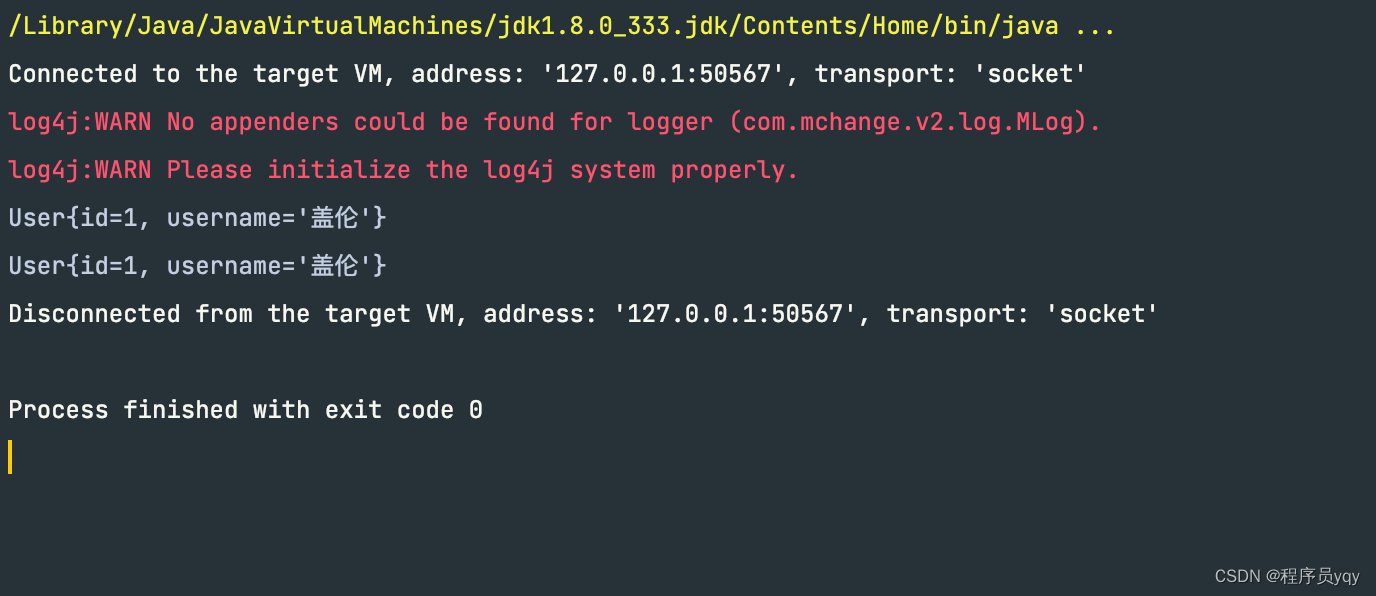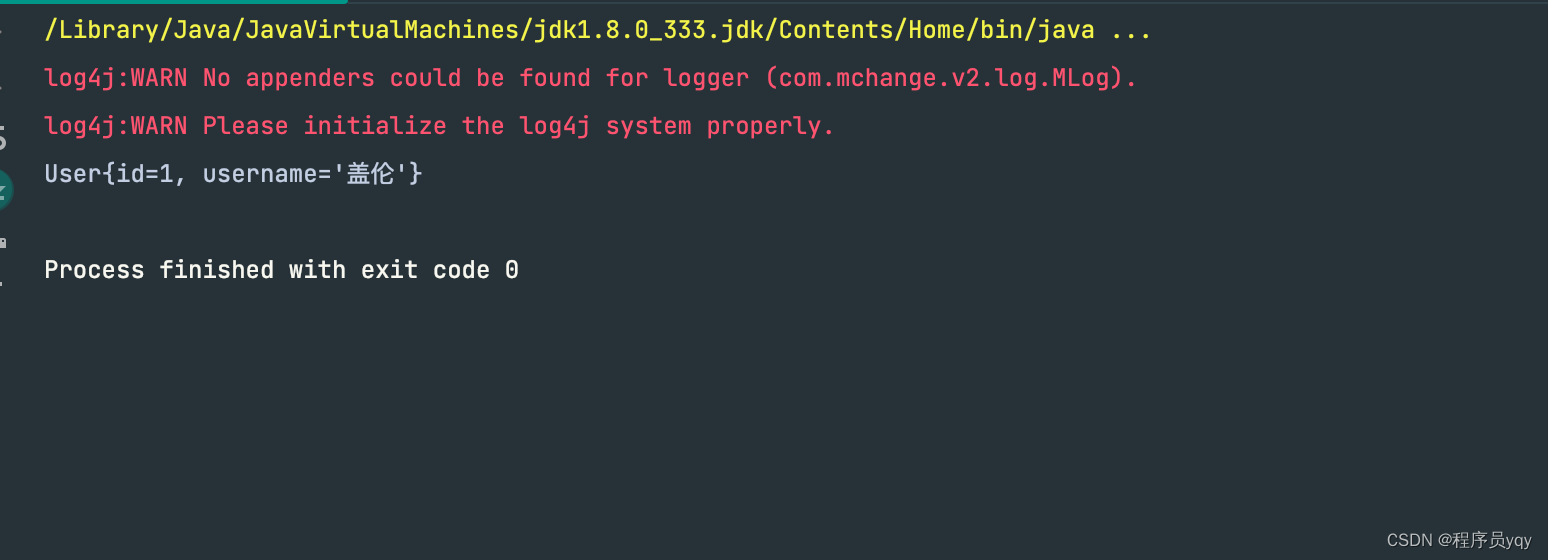本文適合有一定java基礎的同學,通過分析jdbc存在的問題,進行手寫自定義持久層框架,可以更加清楚常用的mybatis等開源框架的原理。 ...
前言
本文適合有一定java基礎的同學,通過自定義持久層框架,可以更加清楚常用的mybatis等開源框架的原理。
JDBC操作回顧及問題分析
學習java的同學一定避免不了接觸過jdbc,讓我們來回顧下初學時期接觸的jdbc操作吧
以下代碼連接資料庫查詢用戶表信息,用戶表欄位分別為用戶id,用戶名username。
Connection connection = null;
PreparedStatement preparedStatement = null;
ResultSet resultSet = null;
User user = new User();
try {
// 載入資料庫驅動
//Class.forName("com.mysql.jdbc.Driver");
Class.forName("com.mysql.cj.jdbc.Driver");
// 通過驅動管理類獲取資料庫鏈接
connection = DriverManager.getConnection("jdbc:mysql://localhost:3306/mybatis?characterEncoding=utf-8", "root", "mimashi3124");
// 定義sql語句?表示占位符
String sql = "select * from user where username = ?";
// 獲取預處理statement
preparedStatement = connection.prepareStatement(sql);
// 設置參數,第⼀個參數為sql語句中參數的序號(從1開始),第⼆個參數為設置的參數值
preparedStatement.setString(1, "蓋倫");
// 向資料庫發出sql執⾏查詢,查詢出結果集
resultSet = preparedStatement.executeQuery();
// 遍歷查詢結果集
while (resultSet.next()) {
int id = resultSet.getInt("id");
String username = resultSet.getString("username");
// 封裝User
user.setId(id);
user.setUsername(username);
}
System.out.println(user);
} catch (
Exception e) {
e.printStackTrace();
} finally {
// 釋放資源
if (resultSet != null) {
try {
resultSet.close();
} catch (SQLException e) {
e.printStackTrace();
}
}
if (preparedStatement != null) {
try {
preparedStatement.close();
} catch (SQLException e) {
e.printStackTrace();
}
}
if (connection != null) {
try {
connection.close();
} catch (SQLException e) {
e.printStackTrace();
}
}
}
查看代碼我們可以發現使用JDBC操作資料庫存在以下問題:
- 資料庫連接創建、釋放頻繁造成系統資源浪費,從⽽影響系統性能。
- Sql語句我們是寫在代碼里的,代碼不容易維護,實際應⽤中sql變化的可能較⼤,sql變動需要改變 java代碼。
- 使⽤preparedStatement向占有位符號傳參數存在硬編碼,因為sql語句的where條件不⼀定,可能多也可能少,修改sql還要修改代碼,系統不易維護。
- 對結果集解析存在硬編碼(查詢列名),sql變化導致解析代碼變化,系統不易維護,如果能將數據 庫記錄封裝成pojo對象解析⽐較⽅便
問題解決思路
- 使⽤資料庫連接池初始化連接資源,避免資源浪費
- 將sql語句抽取到xml配置中,這種sql的變動只用關註xml文件,不比去一堆java代碼里改寫sql
- 參數硬編碼問題可以使用反射、內省等技術、自動將實體與表欄位進行映射。
自己動手寫個持久層框架
接下來,我們來一個個解決上面的問題
資料庫連接池我們可以直接使用c3p0提供的ComboPooledDataSource即可
為瞭解決sql硬編碼問題,我們要把sql寫到xml文件中,那自然是要定義一個xml文件了。
光有sql肯定不行,畢竟我們要先連接資料庫,sql語句才有存在的意義。所以xml中得先定義數據配置信息,然後才是sql語句。
1.定義配置xml文件
我們新建一個sqlMapConfig.xml,定義數據源信息、並且增加兩個sql語句,parameterType為sql執行參數,resultType為方法返回實體。
代碼如下(資料庫不同版本使用驅動類可能不同):
<configuration>
<!--資料庫連接信息-->
<property name="driverClass" value="com.mysql.cj.jdbc.Driver"/>
<!-- <property name="driverClass" value="com.mysql.jdbc.Driver"/>-->
<property name="jdbcUrl" value="jdbc:mysql://localhost:3306/mybatis?serverTimezone=Asia/Shanghai"/>
<property name="username" value="root"/>
<property name="password" value="mimashi3124"/>
<select id="selectOne" parameterType="org.example.pojo.User"
resultType="org.example.pojo.User">
select * from user where id = #{id} and username =#{username}
</select>
<select id="selectList" resultType="org.example.pojo.User">
select * from user
</select>
</configuration>
現在xml文件資料庫信息也有了,sql語句定義也有了,還有什麼問題呢?
我們實際中對sql的操作會涉及到不同的表,所以我們改進一下,把每個表的sql語句單獨放在一個xml里,這樣結構更清晰就容易維護。
優化以後的xml配置現在是這樣了
sqlMapConfig.xml
<configuration>
<!--資料庫連接信息-->
<property name="driverClass" value="com.mysql.cj.jdbc.Driver"/>
<!-- <property name="driverClass" value="com.mysql.jdbc.Driver"/>-->
<property name="jdbcUrl" value="jdbc:mysql://localhost:3306/mybatis?serverTimezone=Asia/Shanghai"/>
<property name="username" value="root"/>
<property name="password" value="mimashi3124"/>
<!--引⼊sql配置信息-->
<mapper resource="mapper.xml"></mapper>
</configuration>
mapper.xml
<mapper namespace="user">
<select id="selectOne" parameterType="org.example.pojo.User"
resultType="org.example.pojo.User">
select * from user where id = #{id} and username =#{username}
</select>
<select id="selectList" resultType="org.example.pojo.User">
select * from user
</select>
</mapper>
順便定義一下業務實體User
public class User {
private int id;
private String username;
public int getId() {
return id;
}
public void setId(int id) {
this.id = id;
}
public String getUsername() {
return username;
}
public void setUsername(String username) {
this.username = username;
}
@Override
public String toString() {
return "User{" +
"id=" + id +
", username='" + username + '\'' +
'}';
}
}
2.讀取配置文件
讀取完成以後以流的形式存在,不好操作,所以我們要做解析拿到信息,創建實體對象來存儲。
- Configuration : 存放資料庫基本信息、Map<唯⼀標識,Mapper> 唯⼀標識:namespace + "." + id
- MappedStatement:存放sql語句、輸⼊參數類型、輸出參數類型
xml解析我們使用dom4j
首先引入maven依賴
代碼如下(mysql驅動版本根據實際使用mysql版本調整):
<properties>
<maven.compiler.source>8</maven.compiler.source>
<maven.compiler.target>8</maven.compiler.target>
</properties>
<dependencies>
<dependency>
<groupId>mysql</groupId>
<artifactId>mysql-connector-java</artifactId>
<version>8.0.22</version>
</dependency>
<dependency>
<groupId>c3p0</groupId>
<artifactId>c3p0</artifactId>
<version>0.9.1.2</version>
</dependency>
<dependency>
<groupId>log4j</groupId>
<artifactId>log4j</artifactId>
<version>1.2.12</version>
</dependency>
<dependency>
<groupId>junit</groupId>
<artifactId>junit</artifactId>
<version>4.10</version>
</dependency>
<dependency>
<groupId>dom4j</groupId>
<artifactId>dom4j</artifactId>
<version>1.6.1</version>
</dependency>
<dependency>
<groupId>jaxen</groupId>
<artifactId>jaxen</artifactId>
<version>1.1.6</version>
</dependency>
</dependencies>
資料庫配置實體 Configuration
public class Configuration {
//數據源
private DataSource dataSource;
//map集合: key:statementId value:MappedStatement
private Map<String,MappedStatement> mappedStatementMap = new HashMap<>();
public DataSource getDataSource() {
return dataSource;
}
public Configuration setDataSource(DataSource dataSource) {
this.dataSource = dataSource;
return this;
}
public Map<String, MappedStatement> getMappedStatementMap() {
return mappedStatementMap;
}
public Configuration setMappedStatementMap(Map<String, MappedStatement> mappedStatementMap) {
this.mappedStatementMap = mappedStatementMap;
return this;
}
}
Sql語句信息實體
public class MappedStatement {
//id
private String id;
//sql語句
private String sql;
//輸⼊參數
private String parameterType;
//輸出參數
private String resultType;
public String getId() {
return id;
}
public MappedStatement setId(String id) {
this.id = id;
return this;
}
public String getSql() {
return sql;
}
public MappedStatement setSql(String sql) {
this.sql = sql;
return this;
}
public String getParameterType() {
return parameterType;
}
public MappedStatement setParameterType(String parameterType) {
this.parameterType = parameterType;
return this;
}
public String getResultType() {
return resultType;
}
public MappedStatement setResultType(String resultType) {
this.resultType = resultType;
return this;
}
}
順便定義一個Resources類來讀取xml文件流
public class Resources {
public static InputStream getResourceAsSteam(String path) {
return Resources.class.getClassLoader().getResourceAsStream(path);
}
}
接下來就是實際的解析了,因為解析代碼比較多,我們考慮封裝類單獨處理解析
定義XMLConfigBuilder類解析資料庫配置信息
public class XMLConfigBuilder {
private Configuration configuration;
public XMLConfigBuilder() {
this.configuration = new Configuration();
}
public Configuration parserConfiguration(InputStream inputStream) throws DocumentException, PropertyVetoException, ClassNotFoundException {
Document document = new SAXReader().read(inputStream);
Element rootElement = document.getRootElement();
List<Element> propertyElements = rootElement.selectNodes("//property");
Properties properties = new Properties();
for (Element propertyElement : propertyElements) {
String name = propertyElement.attributeValue("name");
String value = propertyElement.attributeValue("value");
properties.setProperty(name,value);
}
//解析到資料庫配置信息,設置數據源信息
ComboPooledDataSource comboPooledDataSource = new ComboPooledDataSource();
comboPooledDataSource.setDriverClass(properties.getProperty("driverClass"));
comboPooledDataSource.setJdbcUrl(properties.getProperty("jdbcUrl"));
comboPooledDataSource.setUser(properties.getProperty("username"));
comboPooledDataSource.setPassword(properties.getProperty("password"));
configuration.setDataSource(comboPooledDataSource);
//將configuration傳入XMLMapperBuilder中做sql語句解析。
XMLMapperBuilder xmlMapperBuilder = new XMLMapperBuilder(this.configuration);
List<Element> mapperElements = rootElement.selectNodes("//mapper");
for (Element mapperElement : mapperElements) {
String mapperPath = mapperElement.attributeValue("resource");
InputStream resourceAsStream = this.getClass().getClassLoader().getResourceAsStream(mapperPath);
xmlMapperBuilder.parse(resourceAsStream);
}
return configuration;
}
}
定義XMLMapperBuilder類解析資料庫配置信息
public class XMLMapperBuilder {
private Configuration configuration;
public XMLMapperBuilder(Configuration configuration) {
this.configuration = configuration;
}
public void parse(InputStream inputStream) throws DocumentException,
ClassNotFoundException {
Document document = new SAXReader().read(inputStream);
Element rootElement = document.getRootElement();
String namespace = rootElement.attributeValue("namespace");
List<Element> select = rootElement.selectNodes("select");
for (Element element : select) { //id的值
String id = element.attributeValue("id");
String parameterType = element.attributeValue("parameterType"); //輸⼊參數
String resultType = element.attributeValue("resultType"); //返回參數
//statementId,後續調用通過statementId,找到對應的sql執行
String key = namespace + "." + id;
//sql語句
String textTrim = element.getTextTrim();
//封裝 mappedStatement
MappedStatement mappedStatement = new MappedStatement();
mappedStatement.setId(id);
mappedStatement.setParameterType(parameterType);
mappedStatement.setResultType(resultType);
mappedStatement.setSql(textTrim);
//填充 configuration
configuration.getMappedStatementMap().put(key, mappedStatement);
}
}
}
現在我們可以通過調用配置解析的方法拿到Configuration對象了。但是我們實際使用,肯定是希望我給你配置信息、sql語句,再調用你的方法就返回結果了。
所以我們還需要定義一個資料庫操作介面(類)
3.定義sql操作介面SqlSession
public interface SqlSession {
//查詢多個
public <E> List<E> selectList(String statementId, Object... param) throws Exception;
//查詢一個
public <T> T selectOne(String statementId,Object... params) throws Exception;
}
對操作介面SqlSession做具體實現,這裡主要是通過statementId找到對應的sql信息,進行執行
代碼中simpleExcutor做真正的資料庫語句執行、返回參數封裝等操作
public class DefaultSqlSession implements SqlSession {
private Configuration configuration;
private Executor simpleExcutor = new SimpleExecutor();
public DefaultSqlSession(Configuration configuration) {
this.configuration = configuration;
}
@Override
public <E> List<E> selectList(String statementId, Object... param) throws Exception {
MappedStatement mappedStatement =
configuration.getMappedStatementMap().get(statementId);
List<E> query = simpleExcutor.query(configuration, mappedStatement, param);
return query;
}
@Override
public <T> T selectOne(String statementId, Object... params) throws Exception {
List<Object> objects = selectList(statementId, params);
if (objects.size() == 1) {
return (T) objects.get(0);
} else {
throw new RuntimeException("返回結果過多");
}
}
}
4.編寫資料庫執行邏輯
資料庫操作類DefaultSqlSession中的selectList方法調用到了simpleExcutor.query()方法
public class SimpleExecutor implements Executor {
private Connection connection = null;
@Override
public <E> List<E> query(Configuration configuration, MappedStatement mappedStatement, Object[] params) throws Exception {
//獲取連接
connection = configuration.getDataSource().getConnection();
// select * from user where id = #{id} and username = #{username} String sql =
String sql = mappedStatement.getSql();
//對sql進⾏處理
BoundSql boundSql = getBoundSql(sql);
// 3.獲取預處理對象:preparedStatement
PreparedStatement preparedStatement = connection.prepareStatement(boundSql.getSqlText());
// 4. 設置參數
//獲取到了參數的全路徑
String parameterType = mappedStatement.getParameterType();
Class<?> parameterTypeClass = getClassType(parameterType);
List<ParameterMapping> parameterMappingList = boundSql.getParameterMappingList();
for (int i = 0; i < parameterMappingList.size(); i++) {
ParameterMapping parameterMapping = parameterMappingList.get(i);
String content = parameterMapping.getContent();
//反射
Field declaredField = parameterTypeClass.getDeclaredField(content);
//暴力訪問
declaredField.setAccessible(true);
Object o = declaredField.get(params[0]);
preparedStatement.setObject(i+1,o);
}
// 5. 執行sql
ResultSet resultSet = preparedStatement.executeQuery();
String resultType = mappedStatement.getResultType();
Class<?> resultTypeClass = getClassType(resultType);
ArrayList<Object> objects = new ArrayList<>();
// 6. 封裝返回結果集
while (resultSet.next()){
Object o =resultTypeClass.newInstance();
//元數據
ResultSetMetaData metaData = resultSet.getMetaData();
for (int i = 1; i <= metaData.getColumnCount(); i++) {
// 欄位名
String columnName = metaData.getColumnName(i);
// 欄位的值
Object value = resultSet.getObject(columnName);
//使用反射或者內省,根據資料庫表和實體的對應關係,完成封裝
PropertyDescriptor propertyDescriptor = new PropertyDescriptor(columnName, resultTypeClass);
Method writeMethod = propertyDescriptor.getWriteMethod();
writeMethod.invoke(o,value);
}
objects.add(o);
}
return (List<E>) objects;
}
@Override
public void close() throws SQLException {
}
private Class<?> getClassType(String parameterType) throws ClassNotFoundException {
if(parameterType!=null){
Class<?> aClass = Class.forName(parameterType);
return aClass;
}
return null;
}
private BoundSql getBoundSql(String sql) {
//標記處理類:主要是配合通⽤標記解析器GenericTokenParser類完成對配置⽂件等的解 析⼯作,其中
//TokenHandler主要完成處理
ParameterMappingTokenHandler parameterMappingTokenHandler = new
ParameterMappingTokenHandler();
//GenericTokenParser :通⽤的標記解析器,完成了代碼⽚段中的占位符的解析,然後再根 據給定的
// 標記處理器(TokenHandler)來進⾏表達式的處理
//三個參數:分別為openToken (開始標記)、closeToken (結束標記)、handler (標記處 理器)
GenericTokenParser genericTokenParser = new GenericTokenParser("#{", "}",
parameterMappingTokenHandler);
String parse = genericTokenParser.parse(sql);
List<ParameterMapping> parameterMappings =
parameterMappingTokenHandler.getParameterMappings();
return new BoundSql(parse, parameterMappings);
}
}
上面的註釋比較詳細,流程為
- 根據對應的statementId獲取到要執行的sql語句、調用參數、返回參數。
- 對sql的占位符進行解析、調用參數進行設置
- 根據解析到的入參欄位,通過反射獲取到對應的值,進行sql語句參數設定
- 執行sql語句,使用反射、內省,根據資料庫表和實體的對應關係,完成對象屬性的設置,最終返回結果。
通過以上步驟,我們獲取到了資料庫配置、sql語句信息。定義了資料庫操作類SqlSession,但是我們並沒有在什麼地方調用解析配置文件。
我們還需要一個東西把兩者給串起來,這裡我們可以使用工廠模式來生成SqlSession
使用工廠模式創建SqlSession
public interface SqlSessionFactory {
public SqlSession openSession();
}
public class DefaultSqlSessionFactory implements SqlSessionFactory{
private Configuration configuration;
public DefaultSqlSessionFactory(Configuration configuration) {
this.configuration = configuration;
}
@Override
public SqlSession openSession() {
return new DefaultSqlSession(configuration);
}
}
同時為了屏蔽構建SqlSessionFactory工廠類時獲取Configuration的解析過程,我們可以使用構建者模式來獲得一個SqlSessionFactory類。
public class SqlSessionFactoryBuilder {
public SqlSessionFactory build(InputStream inputStream) throws PropertyVetoException, DocumentException, ClassNotFoundException {
XMLConfigBuilder xmlConfigerBuilder = new XMLConfigBuilder();
Configuration configuration = xmlConfigerBuilder.parserConfiguration(inputStream);
SqlSessionFactory sqlSessionFactory = new DefaultSqlSessionFactory(configuration);
return sqlSessionFactory;
}
}
5.調用測試
終於好了,通過以上幾個步驟我們現在可以具體調用執行代碼了。
public static void main(String[] args) throws Exception {
InputStream resourceAsSteam = Resources.getResourceAsSteam("sqlMapConfig.xml");
SqlSessionFactory sqlSessionFactory = new SqlSessionFactoryBuilder().build(resourceAsSteam);
SqlSession sqlSession = sqlSessionFactory.openSession();
User user = new User();
user.setId(1);
user.setUsername("蓋倫");
User user2 = sqlSession.selectOne("user.selectOne", user);
System.out.println(user2);
List<User> users = sqlSession.selectList("user.selectList");
for (User user1 : users) {
System.out.println(user1);
}
}
代碼正確執行,輸出

⾃定義框架優化
上述⾃定義框架,解決了JDBC操作資料庫帶來的⼀些問題:例如頻繁創建釋放資料庫連接,硬編
碼,⼿動封裝返回結果集等問題,現在我們繼續來分析剛剛完成的⾃定義框架代碼,有沒有什麼問題呢?
問題如下:
- dao的實現類中存在重覆的代碼,整個操作的過程模板重覆(創建sqlsession,調⽤sqlsession⽅ 法,關閉sqlsession)
- dao的實現類中存在硬編碼,調⽤sqlsession的⽅法時,參數statement的id硬編碼
我們可以使用代理模式,生成代理對象,在調用之前獲取到執行方法的方法名、具體類。這樣我們就能獲取到statementId。
為SqlSession類新增getMappper方法,獲取代理對象
public interface SqlSession {
public <E> List<E> selectList(String statementId, Object... param) throws Exception;
public <T> T selectOne(String statementId,Object... params) throws Exception;
//為Dao介面生成代理實現類
public <T> T getMapper(Class<?> mapperClass);
}
public class DefaultSqlSession implements SqlSession {
private Configuration configuration;
private Executor simpleExcutor = new SimpleExecutor();
public DefaultSqlSession(Configuration configuration) {
this.configuration = configuration;
}
@Override
public <E> List<E> selectList(String statementId, Object... param) throws Exception {
MappedStatement mappedStatement =
configuration.getMappedStatementMap().get(statementId);
List<E> query = simpleExcutor.query(configuration, mappedStatement, param);
return query;
}
@Override
public <T> T selectOne(String statementId, Object... params) throws Exception {
List<Object> objects = selectList(statementId, params);
if (objects.size() == 1) {
return (T) objects.get(0);
} else {
throw new RuntimeException("返回結果過多");
}
}
@Override
public <T> T getMapper(Class<?> mapperClass) {
Object proxyInstance = Proxy.newProxyInstance(DefaultSqlSession.class.getClassLoader(), new Class[]{mapperClass}, new InvocationHandler() {
@Override
public Object invoke(Object proxy, Method method, Object[] args) throws Throwable {
// selectOne
String methodName = method.getName();
// className:namespace
String className = method.getDeclaringClass().getName();
//statementId
String statementId = className+'.'+methodName;
Type genericReturnType = method.getGenericReturnType();
//判斷是否實現泛型類型參數化
if (genericReturnType instanceof ParameterizedType){
List<Object> objects = selectList(statementId,args);
return objects;
}
return selectOne(statementId,args);
}
});
return (T) proxyInstance;
}
}
定義業務數據dao介面
public interface IUserDao {
//查詢所有用戶
public List<User> findAll() throws Exception;
//根據條件進行用戶查詢
public User findByCondition(User user) throws Exception;
}
接下來我們只需獲取到代理對象,調用方法即可。
public class Main2 {
public static void main(String[] args) throws Exception {
InputStream resourceAsSteam = Resources.getResourceAsSteam("sqlMapConfig.xml");
SqlSessionFactory sqlSessionFactory = new SqlSessionFactoryBuilder().build(resourceAsSteam);
SqlSession sqlSession = sqlSessionFactory.openSession();
//獲取到代理對象
IUserDao userDao = sqlSession.getMapper(IUserDao.class);
List<User> all = userDao.findAll();
for (User user1 : all) {
System.out.println(user1);
}
}
}
總結
為瞭解決JDBC操作資料庫存在的問題,我們主要幹了這些事
- 定義sql配置文件來存放數據源、sql語句等信息。
- 解析xml文件,存放到類對象Configuration、MappedStatement中。
- 通過反射、自省等技術完成了參數的動態設置、返回結果集的封裝
- 為瞭解決statementId硬編碼問題,我們使用了代理模式創建代理類來獲取statementId信息。
- 在過程中使用到了構建者模式、工廠模式。
以下為本文的大體流程圖:

源碼以及資料庫建表語句鏈接 :java自定義簡易持久層框架
如果本文對你有幫助,請右下角點下




